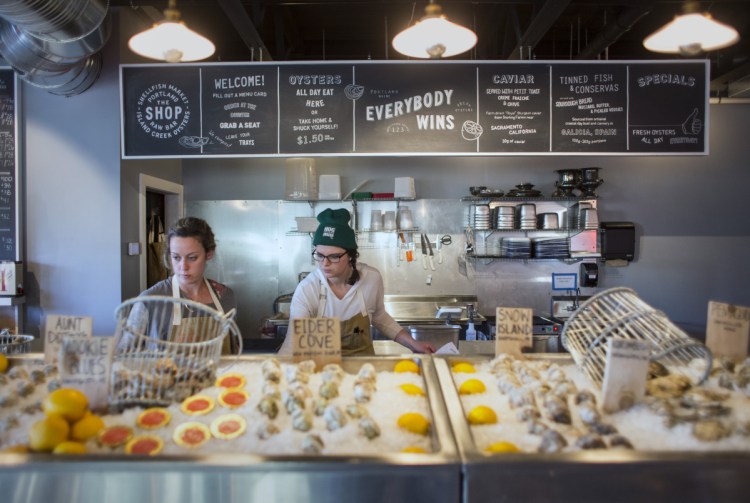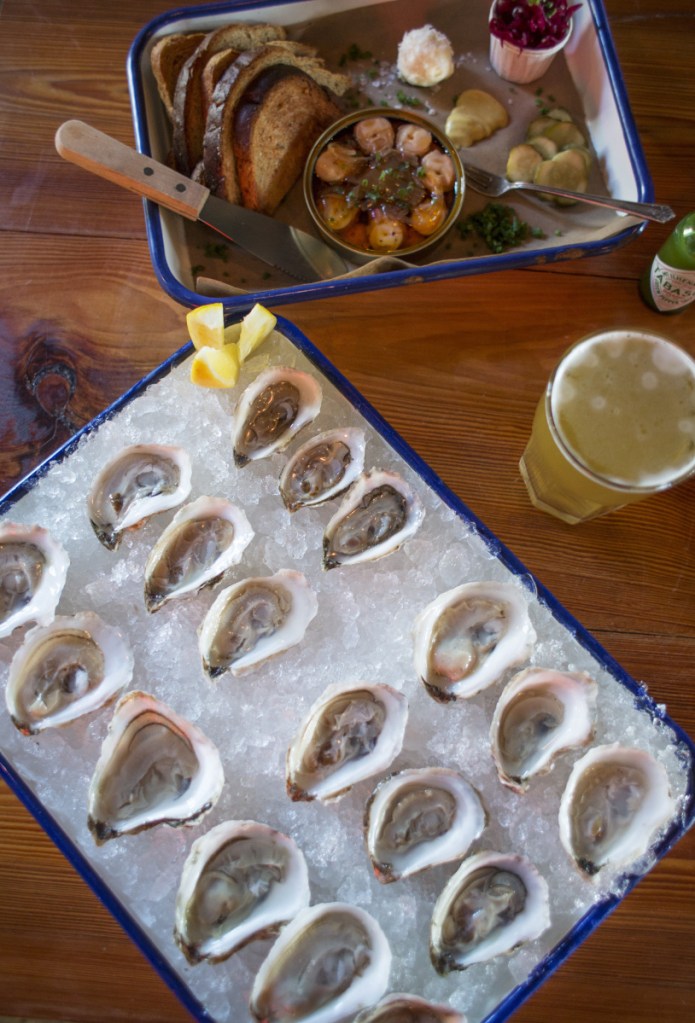When I tell the man behind the counter at The Shop about meeting another Portland shucker – someone so profoundly allergic to shellfish that he winds up in the emergency room every time he accidentally nicks himself with a knife – I see his hands stop moving for a fraction of a second as he squints at me, trying to decide if I’m lying. “That is absolutely insane. Wow,” he replies, with a quick shake of the head. Then without looking down, he grabs another oyster and begins to lever his blade inside. “But you know what? I totally get it,” he says. “He’s in it for the sport.”
At the till, his colleague nods and tells me that the team has already popped open 500 oysters among them, and it’s not even 4 p.m. But that’s nothing: On their busiest day, the crew hit 1,600 by the time the Washington Avenue raw bar closed for the night. “If I didn’t know how to shuck an oyster before, I sure did by the end of that shift,” she tells me, looking at her hands as if they recall that brutal day as well as she does.
Not everyone who works at The Shop – the northernmost outpost of Duxbury, Massachusetts-based Island Creek Oysters – walks in with strong shucking skills. “There’s really no industry for commercial shuckers up here, and that was a really challenging thing for us when it came time to hire when we opened last summer,” Kit Paschal, general manager and former co-owner and bar manager of Roustabout, explained. “But it worked out. Everyone starts out really slow, but when you have to do it hundreds of times a night, you inevitably get faster. You have no choice. I was in the same position myself. I shucked a few over my sink, but never had to blast through three dozen. Then I scheduled myself to work the counter, and I’m happy to say I can keep up with pretty much anyone who works here.”
With a rotating selection of shellfish from the region, The Shop offers customers a chance to sample some of what Island Creek provides to its wholesale clients, whether a shucker is involved or not. Eat-in or take-home, the price for all live shellfish is the same: $1.50 per piece.
That is a remarkably good value, especially considering that some of the very same shellfish eventually finds its way into some of the country’s most expensive restaurants, like New York’s ultra-tony Per Se, which recently posted an Instagram photo of the delicate, Island-Creek-sourced Stonington live bay scallops it features as part of a $340 prix-fixe meal.
The Shop keeps its prices low by not operating as a traditional restaurant. “No hot entrees and counter service only. It’s very casual,” Paschal said. “Even though we’re licensed like a restaurant, we call ourselves a raw bar and market.”
Like an optical illusion, the clean, modern space reads as both. Walk in with the intention of picking up snacks for a dinner party, and you’re likely to focus on the free-standing shelves loaded with branded T-shirts, shucking knives, sauces, and new-and-vintage cookbooks. Walk in hungry, and you’ll make a beeline for the boxy yellow sofas or the bar stools and chest-height tables, thoughtfully outfitted with plenty of under-mounted hooks for coats and handbags.
There’s no real name for the meal The Shop serves, either. Without a single fresh vegetable on the menu, it is not balanced enough to be called lunch or dinner. The closest you’ll get are the accompaniments to the Galician tinned fish platters: thick slices of Morse’s sour mustard pickles and ruby red cabbage sauerkraut from Thirty Acre Farm in Whitefield. “There are definitely people who really wish it was a full dinner, but if it was, there would be a higher cost,” Paschal explained. “It’s just about socializing with a taste of what summer is like … and a cold beverage.”
When I ask Paschal why there’s no dessert, he laughs. “People always have room for more oysters.”
There is something freeing about knowing that you don’t have to hold a little stomach space in reserve – knowing that a few sweet, barely saline Eider Cove oysters from the banks of the New Meadows River in West Bath make as good a dessert as any whoopie pie.
Not that you have to wait until the end of your meal to eat them. On a recent visit, my guests and I took a tour of The Shop’s oyster menu, bookended on either side by Eider Coves. In between, I enjoyed a few of Island Creek’s intensely briny, eponymous oysters from their farm in Duxbury, Massachusetts – a fantastic match for a glass of tart “Piu-Fizz” prosecco ($6 for a glass, $24 for a carafe) and its galaxy of microscopic bubbles.
Along the way, I also tasted dark and earthy Fin de la Baies from New Brunswick, Canada, as well as a tiny Snow Island oyster from Harpswell that started out light and watermelon-esque, with a protractedly sweet finish that seemed to go on for minutes.
Perhaps the most exciting oyster I tasted was also from Harpswell: the Belon, a riparian descendant of the cultivar from Brittany. Also known as European Flats, Belons are fat, with frail, green-daubed shells that describe an almost perfect circle. Inside, the muscle and liqueur are unlike anything found in other North American oysters. Their singular flavor is mineral and explosively metallic, like sipping rainwater through a copper straw. Belons are also nearing the end of their season now, which runs from autumn to late spring, making them a treat for locals only.

Dave Soroka of Portland enjoys an oyster while taking a shucking class with his girlfriend, Makenna Barley, also of Portland.
I prefer them with a glass of something substantial, like the La Nevera Tempranillo ($7 glass/$28 carafe), the only red of The Shop’s three wines available on tap. With a bit of oak and a limber tannic structure, the tempranillo also goes well with Spanish tinned fish. In particular, the Ramon Peña Gold octopus preserved in a tangy sauce of olive oil, tomato and paprika ($27), and the Gold squid preserved in onion, olive oil, tomato and a tarry squirt of its own ink ($18).
Both are served on butcher-paper-lined enamel trays with slices of Standard Baking sourdough toasts, a scoop of sweet butter sprinkled with Maldon salt, and pickles, whose lactic acid fermentation flavors brighten up the otherwise oily seafood.
When I visited on a recent Saturday afternoon, it was still too chilly to eat on the deck, so we sat indoors – underneath Portland artist David Johansen’s flickering crimson rendition of a horseshoe crab – as we assembled cross-sectioned pieces of octopus and squid into miniature sandwiches. Just as we were finishing our last sips of citrusy Paul D. Grüner Veltliner ($7/$26), a herd of college-aged students walked in the door and placed an order for several dozen oysters. I watched the two shuckers on duty glance at each other and smile. “This,” one said as they fist-bumped with gloved hands, “is what we train for.”
Andrew Ross has written about food in the United Kingdom and in New York, where he co-founded NYCnosh, a food website. He and his work have been featured on Martha Stewart Living Radio and in The New York Times. He is an Internet researcher and higher education consultant. Contact him at:
andrewross.maine@gmail.com
Twitter: @AndrewRossME
Send questions/comments to the editors.




Comments are no longer available on this story